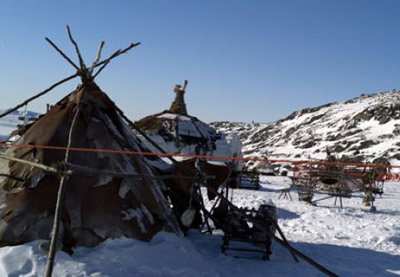
The Lomens regularly purchased the negatives of several other photographers to be reissued under the Lomen Brothers Co.

Within a few years, the family owned a clothing store, pharmacy, stationery store, meatpacking, shipping company, a local photography studio, and the Lomen Reindeer Corporation. The Lomen family was originally from Minnesota and in 1903 they relocated to Nome, Alaska. Their basic social and economic unit was the nuclear family, and their belief system was animistic. In summer many Inuit lived in animal-skin tents.

Most Inuit wintered either in snow-block houses generally referred to as igloos (iglus or igluvigaqs, depending on dialect) or in semisubterranean houses built of stone or sod over a wooden or whalebone framework. Inuit clothing was fashioned of caribou furs, which provided protection against the extreme cold. Dogsleds were the basic means of transport on land. In the summer most Inuit families hunted caribou and other land animals with bows and arrows. Whales were hunted by using a larger boat called an umiak (umiaq or umiat). Inuit used harpoons to kill seals, which they hunted either on the ice or from kayaks-skin-covered one-person vessels. The language is often called Inuktitut, though other local designations are also used.Ī kayaker wearing a waterproof jacket with a toy boat he made for his son.Īccording to various studies, the Eskimo people have lived in the Bering Strait region as an identifiable culture for at least 4,000 to 6,000 years.Ĭulturally, traditional Inuit life was totally adapted to an extremely cold snow- and icebound environment in which vegetable foods were almost nonexistent, trees were scarce, and caribou, seals, walruses, and various whales, seabirds, and fish were the major food sources. The preferred term in Canada’s Central Arctic is Inuinnait, and in the eastern Canadian Arctic Inuit.

Nowadays, in Canada and Greenland, Eskimo is widely considered pejorative and offensive, and has been replaced overall by Inuit. In Canada the term “Inuit” is used rather than “Eskimo,” but most Alaskans use the name “Eskimo,” particularly because “Inuit” refers only to the Inupiat of northern Alaska, the Inuit of Canada, and the Kalaallit of Greenland, and it is not a word in the Yupik languages of Alaska and Siberia. Linguists now believe that “Eskimo” is derived from an Ojibwa word meaning “to net snowshoes.” The term “Eskimo” is used in Alaska to refer to arctic Alaskans including Inupiaq, Yupik, and Alutiiq people. These photographs, taken by the Lomen family, capture the indigenous Yupik Eskimo and the prospectors of the Gold Rush in Alaska during the early decades of the 20th century.


 0 kommentar(er)
0 kommentar(er)
